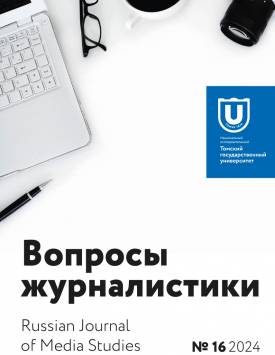Program formats on modern regional television (on the example of the Stavropol TV channel SvoyeTV)
Today, the problem of format definition is one of the key issues both in the theory of television journalism and in professional reflection. This work provides an overview of the most indicative classifications of television formats. The authors of the article base their analysis on the typological approach of A. N. Dedov, according to which it is concluded that the editorial staff of the SvoyeTV channel, showing the “habitat” of Stavropol residents and creating the image of a local resident of the 21st century, in varying volumes and in different forms uses almost all the formats declared in the scientist’s typology - a TV magazine, a conversation, a story, a show, a life-to-tape. The article gives the formats’ characteristics: the features of the genres used are described; the dramatic design of the programs, thematic focus, methods and techniques of presenting information (life, lack of journalistic commentary, etc.) are indicated. The work notes that SvoyeTV television documentaries address culturally significant, historical and social topics, and are made in the format of a story. Such tools for creating authorial documentary projects as poeticization of the narrative, visual metaphor, narration in the form of “living history”, a special genre-stylistic narrative strategy in conveying the content are considered. The authors declare no conflicts of interests.
Keywords
format,
content,
regional television,
documentary film,
TV channel SvoyeTV,
television programsAuthors
| Lepilkina Olga I. | North-Caucasus Federal University | oll5@mail.ru |
| Larionova Yelena N. | North-Caucasus Federal University | ele-molchanova@yandex.ru |
| Ganzhara Olga A. | North-Caucasus Federal University | snark44@yandex.ru |
Всего: 3
References
Morney E. Creative prerequisites for innovation in group collaboration-A case study of slow-TV, the genesis of a Norwegian television genre // Journal of Creativity. 2022. Dec. № 32 (3). P. 100031.
Ильченко С. Н. Типологическая идентичность жанровой системы отечественных электронных СМИ: к постановке проблемы // Вестник Санкт-Петербургского университета. Серия 9. Филология. Востоковедение. Журналистика. 2014. № 1. С. 248-253.
Мясникова М. А. Жанровая и форматная динамика в программировании телеканала "Культура" // Вестник Челябинского государственного университета. 2015. № 5 (360). С. 250-255.
Кемарская И. Н. Формат как способ позиционирования программа: // Вестник Московского университета. Серия 10. Журналистика. 2010. № 6. С. 66-69.
Дедов А. Н. Технологии телевизионной журналистики: учебное пособие. Курган: Курганский государственный университет, 2017.
Никольская Э. С., Макеенко М. И. Формы подачи информации в новостном вещании: практики российских телеканалов // Меди@льманах. 2020. № 2-3. С. 4859.
Ganguly L. Global Television Formats and Their Impact on Production Cultures: The Remaking of Music Entertainment Television in India // Television & New Media. 2019. № 20 (1). P. 20-35.
Choi J. The Materialization of Television Formats // Media Industries. 2022. № 9 (2). P. 21-39.
Worthington Ch. Basics Film-Making 01. Producing AVA Publishing, 2008.
Villegas-Simon I. & Soto-Sanfiel M. T. Similarities in adaptations of scripted television formats: The global and the local in transnational television culture // Poetics. 2021. June. № 86. P. 101524.
Соколова Л. Н. Опыт создания телевизионного ведущего с использованием искусственного интеллекта в эфире регионального телевидения // Актуальные проблема: медиаисследований-2023: сб. материалов ХШ Международной научно-практической конференция НАММИ. М.: Факультет журналистики МГУ, 2023. С. 139-140.
Малышев Д. А. Событие и нарратив в теленовостях, посвященных деятельности политиков. Политическая лингвистика. 2015. № 3 (53). С. 124-133.
Muller K. & Schwarz C. From apprentice to president? Entertainment TV and US elections // The Leadership Quarterly. 2024. June. № 35 (3). P. 101758.
Лепилкина О. И., Манаенко А. С. Творческая концепция программа: "Прямая линия с губернатором Ставропольского края" на региональном телеканале "Свое ТВ" // Медиасреда. 2020. № 17. С. 45-48.
Воронецкая-Соколова Ю. Г. Поэтика телевизионной трансляции: "Алые паруса" // Искусство и образование. 2019. № 5 (121). С. 52-65.
Стежко Н. Г.,Недвецкая П. О. Экранная тревел-журналистика и тревел-блогинг: генезис и сравнительный анализ // Журнал Белорусского государственного университета. Журналистика. 2022. № 2. С. 33-42.
Мясникова М. А. Жизнь регионов России в зеркале телевидения и документального кино: сравнительный анализ инструментария // Вопросы теории и практики журналистики. 2024. № 13 (1). С. 125-139.
Кирия И. В., Новикова А. А. Депрессивное медиапотребление (исследование телевизионных предпочтений сельских жителей) // Вестник Московского университета. Серия 10. Журналистика. 2013. № 5. С. 153-166.
Пронин А. А. Наррация эмоций как элемент когнитивной система: документального фильма // Вестник Томского государственного университета. 2017. № 417. С. 21-24.
Лиховцева А. В., Ананишнев В. В., Пронин М. А. Телегерой - прошлое, настоящее и будущее: многомерность образа // Наука телевидения. 2022. №18 (2). С. 91-113.

